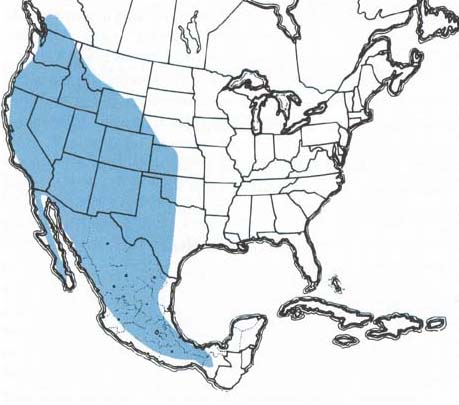Pallidwinged
Grasshopper
|
|
|
|
Geographic range of Trimerotropis pallidipennis (Burmeister) |
|
|
Distribution and
Habitat
Economic
Importance
Food Habits
Migration and
Dispersal
Identification
Hatching
Nymphal
Development
Adults and
Reproduction
Population
Ecology
Selected
References
Distribution and Habitat
The pallidwinged grasshopper, Trimerotropis pallidipennis (Burmeister), ranges from southwestern Canada to Argentina, making it the most widely distributed bandwinged grasshopper in the New World. In North America the primary habitats of this grasshopper lie in the deserts of the West where populations irrupt sporadically to damaging numbers. Vegetation of habitats consists of shrubs, forbs, and grasses with a preponderance of bare ground on which these grasshoppers commonly bask and rest. Outside their usual rangeland habitats, pallidwinged grasshoppers find favorable environmental conditions in weedy city lots.
Economic Importance
Outbreak numbers of the pallidwinged grasshopper damage the forage of their habitats. In Arizona in 1958 populations of nymphs residing in low areas and along washes numbered from 50 to more than 100 per square yard. They fed upon both annual grasses and forbs. Later in spring, the late nymphs and adults migrated into irrigated crops. In small grains, populations of 25 to 50 adults per square yard defoliated wheat and cut off heads. In cotton fields, the grasshoppers numbered 5 to 10 per square yard and consumed seedling plants to ground level. This damage compelled growers to replant large acreages. Some growers found it necessary to replant twice because of persistent grasshopper invasion. Other Arizona crops damaged in 1958 included carrots, sugarbeets, barley, milo, and corn. During outbreaks in California, pallid winged grasshoppers have invaded and damaged fields of safflower and grapes as well as cotton, sugarbeets, barley, and corn.Over a period of 29 years, 1952 to 1980, six outbreaks of the pallidwinged grasshopper occurred in Arizona. These outbreaks have been brief, one lasted two years and the other five lasted only one year. Similar short outbreaks have occurred in the deserts of New Mexico, Utah, and California.
The most recent outbreak took place in west central Arizona in 1998. During the night of April 19 swarms attracted to city lights landed from Lake Havasu City to Bullhead City, a distance of approximately 50 miles. Crushed by traffic on streets and highways, the grasshoppers caused cars and trucks to skid and slide. Accumulations of the grasshoppers around buildings reached a depth of 2 inches.
The pallidwinged grasshopper is a relatively large rangeland grasshopper, but one that varies in weight depending on environmental conditions of its habitat. Live weight of males collected in the Sonoran Desert west of Phoenix, Arizona averaged 268 mg and females 565 mg while males collected in a sagebrush habitat along a hillside above the Gunnison River in Colorado (elevation 1,746 ft.) averaged 175 mg and females 429 mg. Live weight of six young males caught 14 May 2001 in the desert near Mesa, Arizona averaged 261 mg and four immature females 399 mg (dry weight: males 100 mg, females 145 mg).
Food Habits
The pallidwinged grasshopper feeds on a variety of forbs and grasses. Daily diets depend on availability and quality of food plants in the habitat. When eggs hatch in early spring, annual grasses such as downy brome and needle grama (Bouteloua aristioides), are lush and green and serve as the chief food plants. Later in spring the annual grasses become dry and brown, inducing the grasshoppers to switch to green perennial grasses and certain green forbs.A variety of diets has been revealed by several studies of crop contents. In a four-year study, 1966-1969, in south-central Idaho, examination of 153 crops of the pallidwinged grasshopper revealed that 63 percent of crops contained fragments of downy brome and 22 percent tumblemustard. Other plants detected in the crops ranged from a trace to 11 percent. The grasses included crested wheatgrass, thickspike wheatgrass, and Sandburg bluegrass. The forbs included milkvetch, western salsify, big sagebrush, hoary aster, Greene rabbitbrush, and gray rabbitbrush. Also found in crops were fragments of arthropod parts, fungi, and pollen.
Crop analysis of adults collected in southwestern Texas near Alpine in the summer of 1974 showed that forbs were more frequently ingested (64 percent) than grasses (36 percent). However, blue grama grass was the most often ingested single plant, 23 percent, followed by a forb, Cryptantha sp, 16 percent. Other grasses found in crops included Leptoloma cognata (7 percent) and Setaria sp (1 percent); other forbs included Solanum sp (11 percent), Iva sp (10 percent), with smaller percentages of Croton sp, Gaura sp, and Ratibida sp.
In the Sonoran Desert, 30 miles west of Tucson, Arizona, 68 of 126 crops (54 percent) contained needle grama, six crops contained the forb Allionia incamata, four crops contained the forb Franseria deltoidea, and three crops contained arthropod parts.
Although these studies indicate a high degree of polyphagy by the pallidwinged grasshopper, two-choice tests demonstrate that the species has food preferences. Laboratory tests of 15 plant species offered in pairs to adults collected in Millard County, Utah in 1998 revealed preferences for dandelion, kochia, downy brome, crested wheatgrass, and needleandthread.
Migration and Dispersal
The pallidwinged grasshopper possesses remarkably strong powers of flight allowing the species to disperse widely and to escape deteriorating desert habitats as vegetation senesces and dries. Attracted by city lights, flying swarms land at night piling up on streets and sidewalks in enormous numbers. In Arizona during outbreaks, numerous adults have often been recorded as invading crops. Unfortunately, no detailed study has been made of the flights. We do not know the meteorological conditions, the time of day, direction, duration, and distance of flights. Small-scale displacement of the pallidwinged grasshopper was studied in a 2.5 acre plot in 1975 in western Texas, 15 miles east of Alpine. Of the four grasshopper species marked and recaptured, the pallidwinged grasshopper moved the farthest, an average distance of 27 feet per day. Recovery of this grasshopper was low, 25 percent, compared with the other two long-winged species, 36 and 53 percent, indicating that after two weeks a large number of pallidwinged grasshoppers had flown out of the plot area.One of the few observations of actual flight of this species was made in Nevada; where flights were often of long duration, individuals commonly ascending well out of sight. In one case, a male circled about a sagebrush slope for 17 minutes in a single flight before finally coming to rest. In the Phoenix, Arizona area (altitude 1083 feet), pilots have reported swarms at altitudes of 3,000 to 5,000 feet. Flushed grasshoppers fly swiftly at heights of 2 to 3 feet often going more than 100 feet and beyond sight.
A remarkable dispersal record of the species was made 7 September 1966 when adults were discovered along roadsides bordering a sugar plantation at Ewa, Oahu, Hawaii. Specimens sent to the U.S. National Museum were identified by A.B. Gurney. The Hawaiian infestation persisted in 1967 and 1968. Probable source of the infestation was western North America indicating wind transportation of a swarm.
Identification
|
Figures 1-5.
Appearance of the nymphal instars of Trimerotropis pallidipennis-their
sizes, structures, and color patterns. Notice progressive development of wing
pads. BL = body length, FL = femur length, AS = number antennal
segments. |
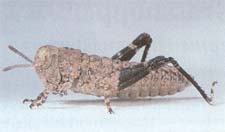 |
|
Fig. 1, First Instar:BL 4.6-6.8 mm FL 2.7-3 mm AS
12-13. |
 |
|
Fig. 2, Second Instar:BL 6.7-8.1 mm FL 3.6-3:9 mm AS
14-15. |
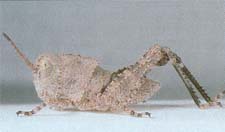 |
|
Fig. 3, Third Instar: BL 9.2-10.8mm FL5.4-5.8mm AS
17-19. |
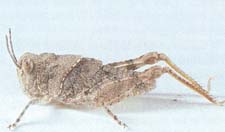 |
|
Fig. 4, Fourth Instar:BL 13.8-15.5 mm FL 7.5-7.9 mm AS
22-23. |
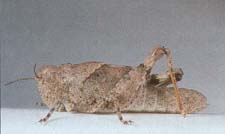 |
|
Fig. 5, Fifth Instar:BL 13.7-20 mm FL 8.5-11.2 mm AS
22-24. |
|
Figures
6-10,Appearance of adult male and female of Trimerotropis
pallidipennis, spread wings of female, inner face of hindleg of female and
pod and opened pod. |
 |
|
Fig. 6, Adult Male:BL
20.5-24 mm FL 12-13.5 mm AS 24-26. |
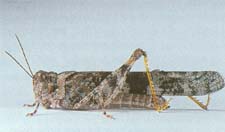 |
|
Fig. 7, Adult Female:BL 27-33 mm FL 13.5-16 mm AS
25-28. |
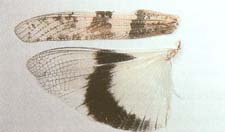 |
|
Fig. 8,Spread wings of female. |
 |
|
Fig. 9, Inner face of female hindleg. |
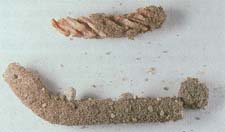 |
|
Fig. 10, Egg pod and
opened egg pod showing eggs. |
The pallidwinged grasshopper belongs to the diverse bandwinged genus Trimerotropis which encompasses more than 40 described species and several yet undescribed. The large number of species with many shared color patterns and structural characteristics present a challenge for accurate identification. Nevertheless a combination of characters make possible the identification of the species.
The pallidwinged grasshopper is a moderately-sized tan or gray insect (Fig. 6 and 7) found chiefly in desert and semidesert habitats. The tegmen bears two transverse dark bands that cross its entire width; the distal end bears numerous brown spots. The center of the hind wing has a relatively narrow but conspicuous black band; the wing disk ranges from white to pale yellow, and the apical area is transparent (Fig. 8). Incised twice near the front, the median carina of the pronotum is high on the prozona and low but distinct on the metazona. The ventral edge of the pronotallobe is straight, bearing no tooth. The inner medial area of the hind femur is black, broken by two yellow bars (Fig. 9). The hind tibia is yellow. The venter is solid cream to pale yellow.The nymphs are identifiable by their structures and color patterns (Fig. 1-5).
- Head with distinct triangular foveolae; carinae of frontal costa straight in instar I and II, carinae slightly incurving at level of antennal sockets in instars III to V; carinae connected by a bridge-like ridge approximately at level of antennal sockets in all instars.
- Pronotum with distinct median carina feebly incised twice in instar I, becoming more strongly elevated and clearly incised in instars II to V; disk rugose on prozona, smooth on metazona; median carina elevated on prozona, low on metazona.
- Hindleg: in instar I mainly black except basal fourth of femur (outer area) pale, inner medial area black with pale distal bar; hind tibia black with pale basal annulus; tarsus white except segment two and distal half of last segment black. In instar II medial area of hind femur pale tan, two dark bars on upper marginal area, inner medial area of hind femur with three black and three pale tan bars; hind tibia black or pale tan. In instars III to V outer and inner surface of hind femur pale tan with two or three black bars; hind tibia yellow.
- Ground color tan spotted brown; venter yellow or olive.
Hatching
The pallidwinged grasshopper hatches early in spring from eggs that have overwintered in the soil. In south-central Arizona the species starts to hatch in late February and continues hatching through March. In west-central Utah (Millard County), hatching begins in late April. Based on the appearance of adults and a nymphal period of 45 days, hatching in late April occurs in southeastern Colorado (Bent County) and in eastern Wyoming (Goshen County). In south-central Arizona a second generation begins to hatch in early June. Only one generation develops in northern Arizona and northern states such as Colorado, Utah, and Wyoming. The evidence suggests that several days after being laid, the eggs cease development and enter a diapause. Yet in an insectary at Mesa, Arizona, eggs kept under moist conditions in a mixture of silt and sand hatched without a diapause in 13 to 21 days (mean 15.5 days) of incubation (air 82° to 104°F, mean 93°F).
In nature rainfall appears to be a critical factor for eggs to survive and hatch. In the Tule Hill site of Millard County, Utah, a moderate population of adults inhabited the site in the summer of 1998, but no eggs hatched by 22 June 1999 apparently having died because of drought.
Nymphal Development
Nymphs appear early in spring when weather is variable but food plants are usually green, nutritious, and plentiful. At this time the length of the nymphal period of individuals ranges from 42 to 48 days. In southern Arizona the nymphs develop during March and April, while in Colorado, Utah, and Wyoming they develop in May and June. A second generation develops in southern Arizona during June; and, under favorable conditions of moisture, additional generations may develop later in the season. In a study conducted in an outdoor screened insectary at Mesa, Arizona, researchers found that female nymphs have five or six instars, while the males usually have five but a few have six. The study also found that the nymphal period of grasshoppers reared at relatively low temperatures in the laboratory (range 70° to 84°F, mean 77°F) averaged 50 days for males and females with five instars and 60 days for females with six instars. The nymphal period of grasshoppers reared during mid summer in the outdoor insectary at relatively high temperatures (range 81 ° to 101°F, mean 91 OF) averaged 31 days for the males and 33 days for the females.
Adults and Reproduction
Depending on the location of the habitat, the adult stage of the pallidwinged grasshopper is reached in mid to late spring. In southern Arizona adults appear in mid April, while in Colorado, Utah, and Wyoming they appear in early June.During the day adults fly about and may disperse widely. In the Alpine, Texas study marked adults were recaptured for only 14 days. On the other hand, in a small favorable habitat of about one acre in the desert of Millard County, Utah, adults have been found in residence from 19 June to 29 August 1998, indicating a habitat fidelity of at least 67 days.
Males make frequent local flights in which they crepitate (snapping sounds produced by the hind wings). Observations indicate that crepitation initiates pair formation of the sexes. Upon landing, the male walks in a straight line to a resting female. Courtship consists of ordinary stridulation which resembles a trilling sound to the human ear. One to eight trills in quick succession are produced by males advancing toward females. A receptive female remains still as the male approaches, mounts, and attaches his genitalia to consumate mating.
Reproductive maturation of females in nature has not been closely followed. However, in south-central Arizona adults that fledged by the end of April in a habitat of succulent vegetation bore well-developed eggs a week later, but no eggs were found in females inhabiting dry desert.
Caged in pairs and sheltered in a screened insectary during mid summer (76° to 101°F, mean 88°F), and fed a mixed diet of four species of host plants, pallidwinged grasshoppers exhibited a high fecundity, comparing favorably with other pest species of grasshoppers. Sixteen females averaged 386 eggs each. One female laid a record 27 pods containing 955 eggs. The preoviposition period was long with a minimum of 26 days and an average of 43 days. Average longevity of these females was 80 days. In nature the eggs are laid in bare soil to a depth of approximately 1 inch. The pod is slightly curved, narrow (118 inch in diameter), and 1 inch long (Fig. 10). Each pod contains an average of 34 pale yellow eggs, 4.5 to 5 mm long.
Population Ecology
Irruptions of the pallidwinged grasshopper occur sporadically in the deserts of western North America. In Arizona outbreaks have been associated with above normal, well-distributed rainfall during the preceding fall, winter, and early spring. The ample moisture provides favorable soil conditions for the eggs and a steady supply of nutritious food plants for the nymphs and adults. Populations inhabiting specific sites, however, have not been monitored to determine the time required for the pallidwinged grasshopper to reach high densities. In Idaho dense populations have numbered five adults per square yard. Outbreaks are of short duration, usually only one year, at most two. Evidently individuals of swarms that alight in cities die for lack of food, while those that migrate into crops are destroyed with insecticides or cultural practices. Between outbreaks, periods of usually three to four years, pallidwinged grasshoppers are rare in desert habitats. Apparently, favorable weather and the great fecundity of the species foster a rapid growth of populations.Selected References
Barnes, O.L. 1960. Observations on the desert grasshopper, Trimerotropis pallidipennis pallidipennis, in Arizona. J. Beon. Entomol. 53: 721-724.Barnes, O.L. 1963. Observations on the life history of the desert grasshopper (Trimerotropis pallidipennis pallidipennis) in laboratory and insectary cages. J. Econ. Entomol. 56: 525-528.
Chappell, M.A. 1983. Thermal limitations to escape response in desert grasshoppers. Anim. Behav. 31: 1088-1093.
Joorn, A 1983. Small-scale displacements of grasshoppers (Orthoptera: Acrididae) within arid grasslands. 1. Kansas, Entomol. Soc. 56: 131-139.
Massion, D.D. 1983. An altitudinal comparison of water and metabolic relations in two acridid grasshoppers (Orthoptera). Comp. Biochem. Physiol. 74A: 101-105.
Otte D. and A Joorn. 1977. On feeding patterns in desert grasshoppers and the evolution of specialized diets. Proceed. Acad. Nat. Sci. Philadelphia 128: 89-126.
Scoggan, AC. and M.A. Brusyen. 1972. Differentiation and ecology of common immature Gomphocerinae and Oedipodinae (Orthoptera: Acrididae) of Idaho and adjacent areas. Melanderia 8: 1-76.
